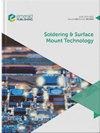Local solidification thermal parameters affecting the eutectic extent in Sn-Cu and Sn-Bi solder alloys
IF 1.7
4区 材料科学
Q3 ENGINEERING, ELECTRICAL & ELECTRONIC
引用次数: 2
Abstract
Purpose Overall, selection maps about the extent of the eutectic growth projects the solidification velocities leading to given microstructures. This is because of limitations of most of the set of results when obtained for single thermal gradients within the experimental spectrum. In these cases, associations only with the solidification velocity could give the false impression that reaching a given velocity would be enough to reproduce a result. However, that velocity must necessarily be accompanied by a specific thermal gradient during transient solidification. Therefore, the purpose of this paper is to not only project velocity but also include the gradients acting for each velocity. Design/methodology/approach Compilation of solidification velocity, v, thermal gradient, G, and cooling rate, Ṫ, data for Sn-Cu and Sn-Bi solder alloys of interest is presented. These data are placed in the form of coupled growth zones according to the correlated microstructures in the literature. In addition, results generated in this work for Sn-(0.5, 0.7, 2.0, 2.8)% Cu and Sn-(34, 52, 58)% Bi alloys solidified under non-stationary conditions are added. Findings When analyzing the cooling rate (Ṫ = G.v) and velocity separately, in or around the eutectic composition, a consensus cannot be reached on the resulting microstructure. The (v vs. G) + cooling rate diagrams allow comprehensive analyzes of the combined v and G effects on the subsequent microstructure of the Sn-Cu and Sn-Bi alloys. Originality/value The present paper is devoted to the establishment of (v vs. G) + cooling rate diagrams. These plots may allow comprehensive analyses of the combined v and G effects on the subsequent microstructure of the Sn-Cu and Sn-Bi alloys. This microstructure-processing mapping approach is promising to predict phase competition and resulting microstructures in soldering of Sn-Cu and Sn-Bi alloys. These two classes of alloys are of interest to the soldering industry, whereas manipulation of their microstructures is considered of utmost importance for the metallurgical quality of the product.影响Sn-Cu和Sn-Bi焊料合金共晶程度的局部凝固热参数
目的总体而言,关于共晶生长程度的选择图反映了导致给定微观结构的凝固速度。这是因为当对实验光谱内的单个热梯度获得时,大多数结果集的局限性。在这些情况下,仅与凝固速度相关可能会给人一种错误的印象,即达到给定的速度就足以重现结果。然而,在瞬态凝固过程中,该速度必须伴随特定的热梯度。因此,本文的目的不仅是投影速度,还包括作用于每个速度的梯度。凝固速度v、热梯度G和冷却速率的设计/方法/方法汇编,Ṫ, 介绍了感兴趣的Sn-Cu和Sn-Bi焊料合金的数据。根据文献中的相关微观结构,这些数据以耦合生长区的形式放置。此外,添加了在非稳态条件下凝固的Sn-(0.5,0.7,2.0,2.8)%Cu和Sn-(34,52,58)%Bi合金在本工作中产生的结果。查找分析冷却率时(Ṫ = G.v)和速度,在共晶成分中或周围,不能就所得微观结构达成一致。(v vs.G)+冷却速率图允许综合分析v和G对Sn-Cu和Sn-Bi合金随后微观结构的组合影响。独创性/价值本文致力于建立(v vs.G)+冷却速率图。这些图可以允许综合分析v和G对Sn-Cu和Sn-Bi合金的随后微观结构的组合影响。这种微观结构处理映射方法有望预测Sn-Cu和Sn-Bi合金焊接中的相竞争和由此产生的微观结构。这两类合金受到焊接行业的关注,而对其微观结构的控制被认为对产品的冶金质量至关重要。
本文章由计算机程序翻译,如有差异,请以英文原文为准。
求助全文
约1分钟内获得全文
求助全文
来源期刊

Soldering & Surface Mount Technology
工程技术-材料科学:综合
CiteScore
4.10
自引率
15.00%
发文量
30
审稿时长
>12 weeks
期刊介绍:
Soldering & Surface Mount Technology seeks to make an important contribution to the advancement of research and application within the technical body of knowledge and expertise in this vital area. Soldering & Surface Mount Technology compliments its sister publications; Circuit World and Microelectronics International.
The journal covers all aspects of SMT from alloys, pastes and fluxes, to reliability and environmental effects, and is currently providing an important dissemination route for new knowledge on lead-free solders and processes. The journal comprises a multidisciplinary study of the key materials and technologies used to assemble state of the art functional electronic devices. The key focus is on assembling devices and interconnecting components via soldering, whilst also embracing a broad range of related approaches.
 求助内容:
求助内容: 应助结果提醒方式:
应助结果提醒方式:


